Every time I hear the word ‘kibby’ I think ‘friendship’ and ‘hefty hugs.’ Back in the late 40’s and 50’s I remember the excitement when Sam Nichols, a local merchant, called my mother to say he was planning a visit. Would she and the good doctor like to have some kibby? Mama’s eyes would light up, and she’d practically dance. In our house, a gift of kibby was better’n Black Magic Chocolates.
When Mr. Nichols arrived, he always had a bear hug for Mama and a vigorous hand shake for my father. The dish of raw meat was rushed off to the fridge, and I knew it would be served for supper, with lots of lip-smacking oohs and ahhs.
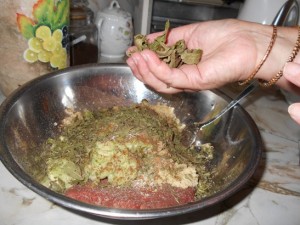 Kibby (also spelled kibbeh, kibbe, kebbee, or kebbah) is made with finely ground meat (usually beef or lamb), bulgur, dried mint and spices. It is served both raw and cooked. If you are a steak tartare lover you’ll likely go gaga over raw kibby. I prefer it as it’s much smoother and more flavourful than steak tartare … but I digress.
Kibby (also spelled kibbeh, kibbe, kebbee, or kebbah) is made with finely ground meat (usually beef or lamb), bulgur, dried mint and spices. It is served both raw and cooked. If you are a steak tartare lover you’ll likely go gaga over raw kibby. I prefer it as it’s much smoother and more flavourful than steak tartare … but I digress.
The next time I had this dish was as an adult, at Julia and Nelson Surette’s home in Mavilette. As years went by, we had many meals there with her daughter Sheila Nichols, and other guests. This is where I learned to appreciate a Lebanese kitchen and this culture’s approach to food.
First of all, you have to understand that eating Lebanese food is an experience. It’s important not only to savour your food, but your company! In many Lebanese homes, it’s customary to have a “mezze”—a meal consisting of many small dishes or appetizers. For her 75th birthday, Julia and Sheila prepared 22 dishes over three weeks, then invited friends and family for mezze. Over the course of five to six hours, one dish was served at a time. Everyone talked up a storm, recounted stories, and occasionally took a break to play a table game.
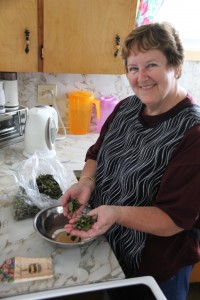 For years my husband and our three offspring got together with Julia, Nelson and Sheila on Boxing Day, along with other guests. Lebanese food always took centre stage (along with lots of hugs), and kibby was always on the menu.
For years my husband and our three offspring got together with Julia, Nelson and Sheila on Boxing Day, along with other guests. Lebanese food always took centre stage (along with lots of hugs), and kibby was always on the menu.
So you may be wondering what this has to do with The July Project? For starters, along with doing something new-to-me everyday in my own backyard, one of my goals was to spend more time with friends. When I emailed Sheila to ask if we could get together for a kibby lesson, the instant reply was affirmative.
Now you have to understand that making kibby is involved. It’s not hard to make, but the initial preparation of the meat is extremely time consuming. Working with raw meat is the issue. Gives a whole new meaning to the old line, “Cleanliness is next to Godliness.”
Nutshell: order a lean round roast beef from a meat cutter who knows you are making kibby and how important it is to have his cutting equipment, knives and counter sterilized before preparing the roast for you. Bring meat home, soak in cold salted water before preparations start. Wash everything you use—counter space, all knives, stainless steel bowls etc.—with hot soapy water & Javex. Thinly slice all outside edges of roast, but only make ONE cut at a time. Wash your knife again in soapy water/Javex after every single cut.
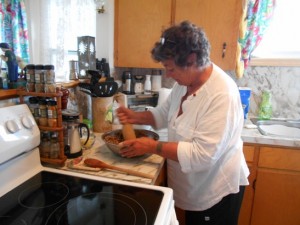 The outside layers of meat can be used for stir fries, ground up for hamburgers etc., but cannot go into the kibby. Next, cut the roast into small hunks … again, making only ONE cut with a knife then wash it again. Grind meat (in a sterilized food processor of course.) Bag in 1-lb. bags and refrigerate if you are going to use meat the same day. Or freeze until the appointed time.
The outside layers of meat can be used for stir fries, ground up for hamburgers etc., but cannot go into the kibby. Next, cut the roast into small hunks … again, making only ONE cut with a knife then wash it again. Grind meat (in a sterilized food processor of course.) Bag in 1-lb. bags and refrigerate if you are going to use meat the same day. Or freeze until the appointed time.
Now, using Julia’s recipe, place 2 C of bulgur in a sieve. Rinse with cold water. Place sieve in a small bowl of water so the bulgur can soak it up and get soft (takes awhile). If you are making raw kibby, use only ¾ of the bulgur. If cooking it, use all.
Blend (in a blender or food processor) 1 small onion, ¼ green pepper, handful of dried mint, 2 tsp. salt, a tsp. pepper, 1 tsp. cinnamon, 1 heaping tsp. cumin, ½ tsp. allspice
Then, mix together all the spices, bulgur and meat. Using a large wooden pestle, pound and work everything together, until it gets smooth. This takes time (and elbow grease.)
NOTE: Julia’s original hand-written recipe says, “For raw—grind your own meat. Lamb is best today unless you know the cow.” I’m sure Sheila would add, “Or unless you know the butcher.”
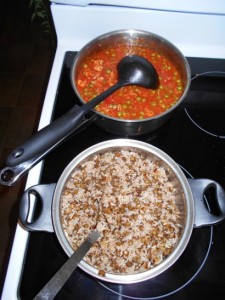 If you want to cook the kibby, Julia’s recipe reads: Put Mazola in bottom baking dish. Dump in kibby. Pat to spread. Cut in squares or diamonds. Slide knife around outside edges. Pour Mazola over top just to cover. Add few dots butter. Bake 400 degrees for 30-45 minutes—just till light brown.
If you want to cook the kibby, Julia’s recipe reads: Put Mazola in bottom baking dish. Dump in kibby. Pat to spread. Cut in squares or diamonds. Slide knife around outside edges. Pour Mazola over top just to cover. Add few dots butter. Bake 400 degrees for 30-45 minutes—just till light brown.
During the course of the afternoon, Sheila also showed me how to make Judra, and had a pot of Humsa on the go. (Both recipes below.) Later, others joined us for a meal that was fit for Pharoahs. Oh yes. We didn’t leave before a round of big fat hugs were dished out. Like I said—kibby, friendship, and hugs are synonymous.
ps: Recently, while going through some old recipes, I found this wonderful “sweet” that Julia gave me years ago. It’s called Dibiss Bi Tahini. Mix some Tahini with molasses (about 2:1) and spread on pita bread. It’s not only simple, it’s addictive.
JUDRA
Put 1 C lentils, 1 C rice, 2 C hot water in pot. Cover. Bring to boil and simmer until almost tender.
Fry 1 chopped onion in ¼ C Mazola oil until brown. Add salt. Then put this mixture into lentil/rice mix. Stir lightly together and finish cooking the rice/lentils on low heat.
Judra is good hot or cold. Serve with yoghurt on top.
HUMSA
In pan put: 1 lb. hamburg (or small chunks of chicken), 2 TB Mazola, 1-2 chopped onions. Brown 10 min.
Add: salt and pepper, 1 tsp. cinnamon, ¼ tsp. cumin, ½ tsp. garlic salt (2 chopped fresh cloves if you have it), and slices of green pepper (if you have it.)
Stir the above then add 1 can tomatoes, ½ C water OR 2-4 TB tomato paste and 1 ½ C water.
Cook covered 15 min or simmer slowly until thickened. Taste for salt. You can add diced potatoes for Mausaka OR you can add string beans, or peas, or eggplant or okra.
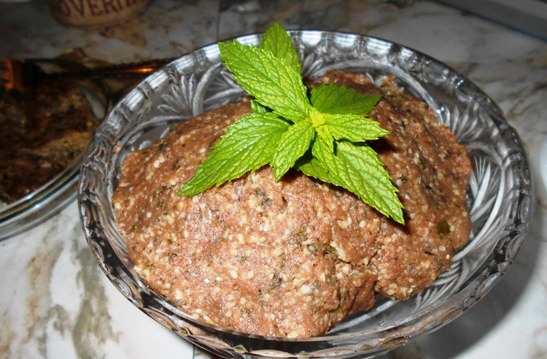

Mazola??? If ever I should get this adventurous, I think I would use EVOO. It just seems more authentic. Anyway evolution. I had raw kibbi once at Mike Allen’s – tasty. I remember Sarah Link’s and my own cooked kibbeh. Back when I was more domestic and the climate was cooler.
Great to see you pop into view John. I’m not sure if there’s a reason to use Mazola over an olive oil like EVOO but I will ask Sheila. And, yes, making kibby in your climate would be an extra challenge at many levels. Best done here! And oh, dear Sarah Link. Yes. What a cook!
Sandra:
I’ve never had kibby but we grew up next door to the Nichols family and they were great neighbours. About twenty years later, I bought one of Nelson Surette’s beautiful paintings (this one of a Cape Island boat sailing on a grey, windy day) and renewed acquaintances with Mrs. Nichols at their home just past Mavillete Beach, where we used to spend many a Sunday afternoon. Please give Sheila my regards, and thanks for the trip down memory lane.
John Filliter
Thanks for popping into view John! I hope Sheila will “see” your response. If not, I will certainly pass on your kind remarks. Lots of memories in Mavilette. And I’m sure you continue to enjoy Nelson’s painting.
Wonderful post, Sandra! I am familiar with kibbeh, there is a large Lebanese community here in Sydney and friends of mine always bring kibbeh to potlucks. I love it! Thanks for the recipes!
Ahhh. Another kibbeh lover. And yes, I remember reading about a large Lebanese community in Sydney! Wonderful.